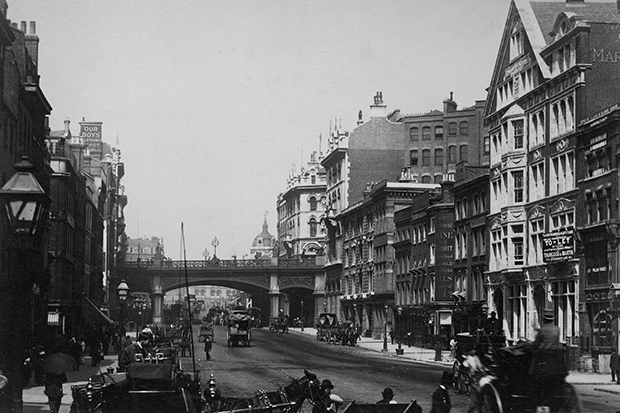I found my first of London’s many lost rivers when I walked across Holborn Viaduct, looked down at the sweep of Farringdon Road below and realised that it had to be the path of a river, not just a road. Indeed, I was soon to learn that the river Fleet runs directly beneath, coursing down to meet the Thames by Blackfriars Bridge.
The Fleet is perhaps the most famous of London’s lost rivers; it was once large enough for boats to navigate it, and an anchor has been discovered as far up as Kentish Town. As for the lower stretch of the Fleet, its earliest recorded cargo were the stones that built the old St Paul’s Cathedral in the early 12th century, but by the 18th century it had degenerated into the Fleet Ditch, so filthy that Alexander Pope, in his poem The Dunciad, wrote that children swam ‘where Fleet-ditch, with disemboguing streams/ Rolls the large tribute of dead dogs to Thames.’
The innocuous grey tarmac of Farringdon Road covers a wealth of river-related stories and secrets. What makes London’s lost rivers quite so tantalising is that they are not entirely lost — traces remain, offering us clues to what lies beneath. Sometimes, as with Farringdon Road, it is the shape of a street which gives the river away. The meanders of Marylebone Lane and Pimlico’s Tachbrook Street echo the course of the river Tyburn below. Further west, Bollo Brook followed the winding course of Bollo Lane, explaining why this street is the boundary between the boroughs of Hounslow and Ealing. Occasionally there is a plaque to commemorate the river’s passage; there used to be one for the Fleet on the wall of Nando’s in Kentish Town, but alas it is now painted over.
Sometimes you can glimpse the river itself, especially after a heavy spell of rain. The river Peck can be seen running through Peckham Rye park, and Counter’s Creek (albeit converted into Kensington Canal) can be seen in full flow by Lots Road power station in Chelsea. Many of the rivers have been transformed into sewers, and can be spotted as such. The Westbourne — now the Ranelagh Sewer — flows through a pipe which crosses over the platforms at Sloane Square Tube station. The course of the river Effra is indicated by the run of Victorian stink pipes along Brixton’s Dulwich Road.
The rivers aren’t only felt in London’s physical landscape, but in its street and place names, too. The city is awash with places ending ‘bourne’, ‘brook’, ‘bridge’ — we are just so used to thinking of them in their current contexts that we’ve forgotten the watery etymology. Call the river to mind and the place is transformed. Knightsbridge, now the preserve of the inordinately wealthy, was once a crossing of the Westbourne, and a favourite stomping ground for thieves and highwaymen. Remember Turnmills, the infamous nightclub of the 1990s? Located on Turnmill Street near Farringdon Station, its name recalls the days when so many mills lined the Fleet that it was known as ‘Turnmill Brook’. Or go for a beer in Brixton and you might find yourself drinking locally brewed Effra Ale, in the Effra Hall Tavern.
London is always changing; that is its great thrill. Look up and you can feel dizzy at all the new skyscrapers, the cranes and construction, but while its future beckons, it is also surprisingly easy to conjure the city’s past into view. Find your first lost river and, like me, you’ll soon be hooked.






Comments